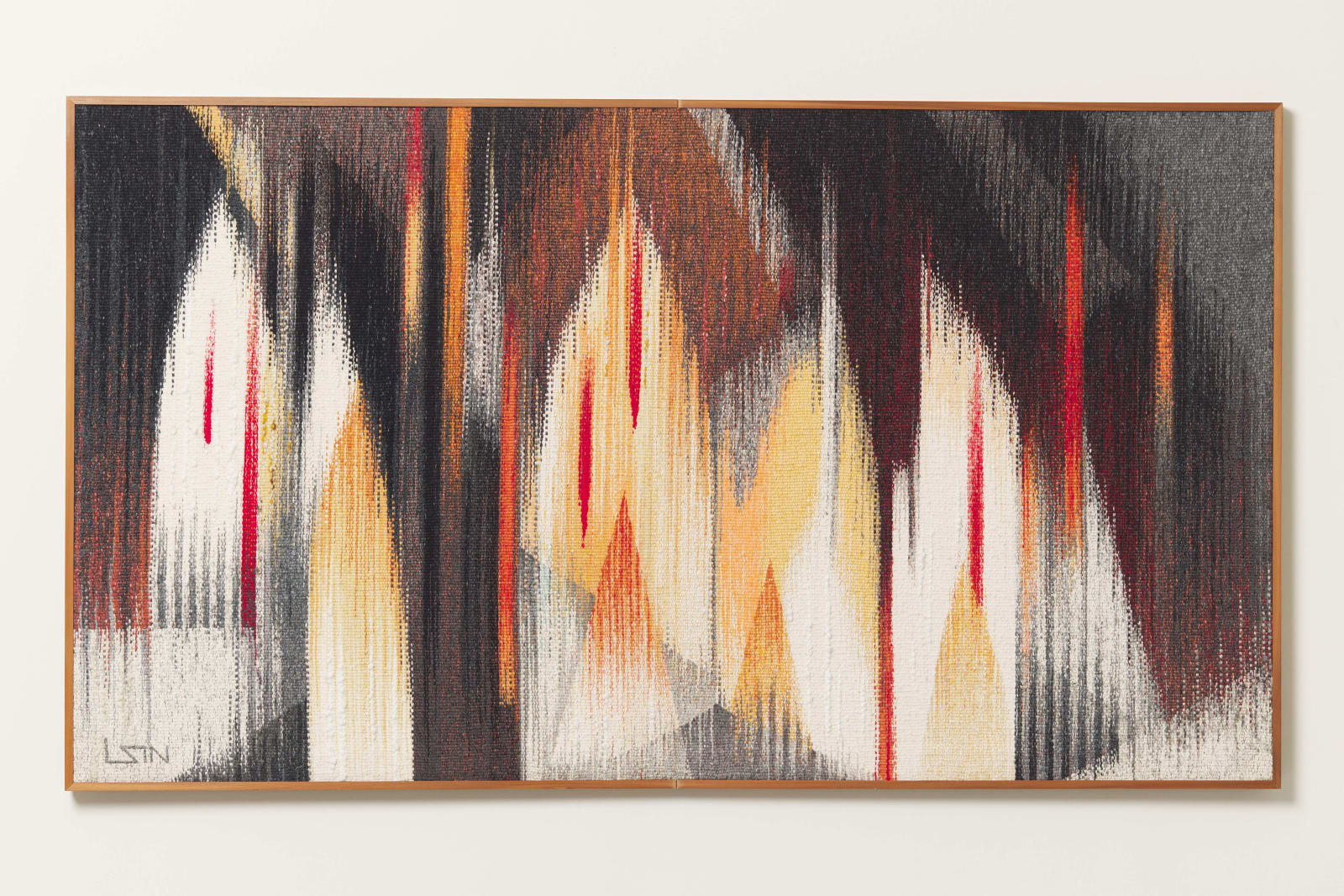
Lee ShinJa
Image of Light, 1987
Wool thread; tapestry
Framed:
46 1/2 x 82 x 2 in
118.1 x 208.3 x 5.1 cm
46 1/2 x 82 x 2 in
118.1 x 208.3 x 5.1 cm
Lee ShinJa (b. 1930) is a pioneering first-generation Korean fiber artist and educator. During the 1950s and ’60s, when working with thread and fabric was considered domestic labor, Lee broke...
Lee ShinJa (b. 1930) is a pioneering first-generation Korean fiber artist and educator. During the 1950s and ’60s, when working with thread and fabric was considered domestic labor, Lee broke new ground in the evolution of Korean craft. Against the conventions of traditional craft, she experimented with modern formal techniques, driving innovations in embroidery, dyeing, weaving, and tapestry to expand the breadth and depth of the genre, which at the time was still unestablished.
In the 1980s, after visiting the 1970 Osaka Expo and the 1983 Lausanne International Tapestry Biennale, Lee gained the confidence to expand her textile forms into sculptural installations. During this decade, she also met and engaged with international artists like Magdalena Abakanowicz and Issey Miyake through textile exhibitions at the National Museum of Modern and Contemporary Art, Korea. Reflecting her remarkable dedication, Lee’s large-scale woven works became increasingly experimental, incorporating bold colors and extensive weaves. Despite her prolific output, she faced personal sorrow in 1982 with the passing of her husband, painter Chang Woon Sang.
Amid the loss of her husband and the challenges of single parenthood, Lee discovered a renewed passion for artistic creation. In the 1980s, she drew inspiration from the sea and landscapes of her hometown, Uljin. Her work from this period captures memories of Uljin's coastal waters and sunrises through semi-abstract and abstract forms, reflecting her exploration of what feels "real" within her consciousness and memory. Depicting mountains, trees, birds, and the moon, she rendered these natural elements in semi-abstract ways. Image of Light exemplifies this phase, featuring repeated conical and triangular motifs with vertical red and orange lines, evoking abstracted mountains or the play of light across the landscape. Lee closely observed how light altered tones and contrasts, using chromatic variations to convey both brightness and shadow. By layering different colored threads, she created complex hues and subtle contrasts reminiscent of soft brushstrokes. Art critic Kim BokYong described Lee’s work as “a metaphor of light and a space of memory.”*
* Kim BokYong, “The Metaphor of Light and the Space of Memories,” The 5th Lee ShinJa Tapestry Exhibition: Nature, Spirit, and Life, exh. cat. (Seoul: Korea Fiber Artists Association, 1993), n.p.
In the 1980s, after visiting the 1970 Osaka Expo and the 1983 Lausanne International Tapestry Biennale, Lee gained the confidence to expand her textile forms into sculptural installations. During this decade, she also met and engaged with international artists like Magdalena Abakanowicz and Issey Miyake through textile exhibitions at the National Museum of Modern and Contemporary Art, Korea. Reflecting her remarkable dedication, Lee’s large-scale woven works became increasingly experimental, incorporating bold colors and extensive weaves. Despite her prolific output, she faced personal sorrow in 1982 with the passing of her husband, painter Chang Woon Sang.
Amid the loss of her husband and the challenges of single parenthood, Lee discovered a renewed passion for artistic creation. In the 1980s, she drew inspiration from the sea and landscapes of her hometown, Uljin. Her work from this period captures memories of Uljin's coastal waters and sunrises through semi-abstract and abstract forms, reflecting her exploration of what feels "real" within her consciousness and memory. Depicting mountains, trees, birds, and the moon, she rendered these natural elements in semi-abstract ways. Image of Light exemplifies this phase, featuring repeated conical and triangular motifs with vertical red and orange lines, evoking abstracted mountains or the play of light across the landscape. Lee closely observed how light altered tones and contrasts, using chromatic variations to convey both brightness and shadow. By layering different colored threads, she created complex hues and subtle contrasts reminiscent of soft brushstrokes. Art critic Kim BokYong described Lee’s work as “a metaphor of light and a space of memory.”*
* Kim BokYong, “The Metaphor of Light and the Space of Memories,” The 5th Lee ShinJa Tapestry Exhibition: Nature, Spirit, and Life, exh. cat. (Seoul: Korea Fiber Artists Association, 1993), n.p.
Provenance
The artistExhibitions
Lee ShinJa: Drawing with Thread, Berkeley Art Museum and Pacific Film Archive (BAMPFA), Berkeley, August 6, 2025–February 1, 2026.Lee ShinJa: Weaving the Dawn, Tina Kim Gallery, New York, August 22–September 28, 2024.
Lee ShinJa: Threadscapes, National Museum of Modern and Contemporary Art (MMCA), Gwacheon, Korea, September 22, 2023–February 18, 2024.
Literature
Lee ShinJa: Threadscapes (Seoul: National Museum of Modern and Contemporary Art, Korea, 2023), pp. 194–195.Lee ShinJa Tapestry Arts II (Seoul: Thinking and Feeling, 2003), pp. 56–57.